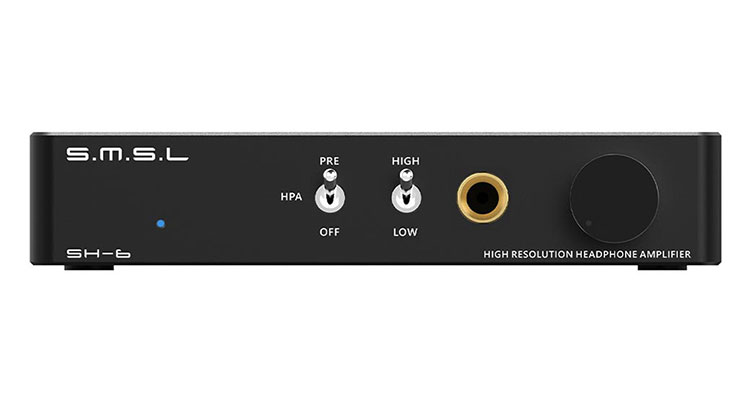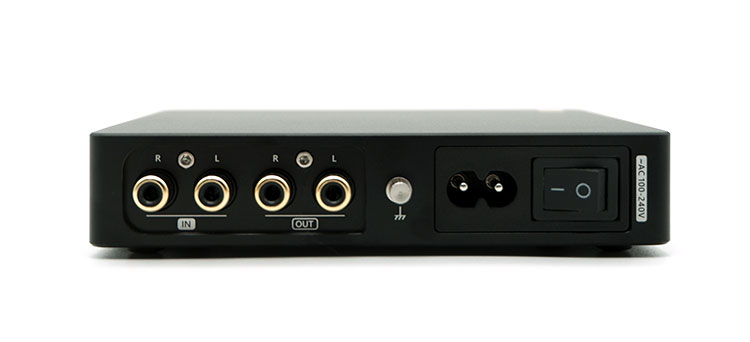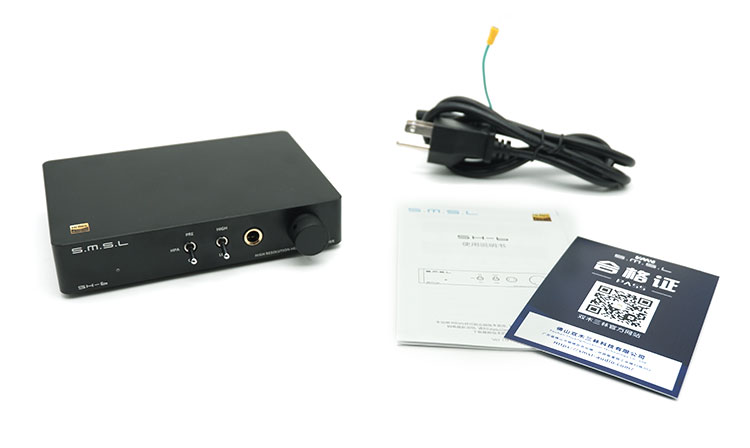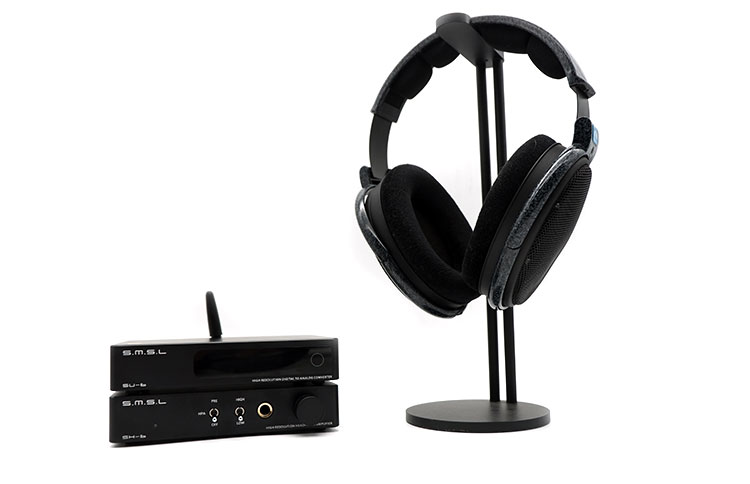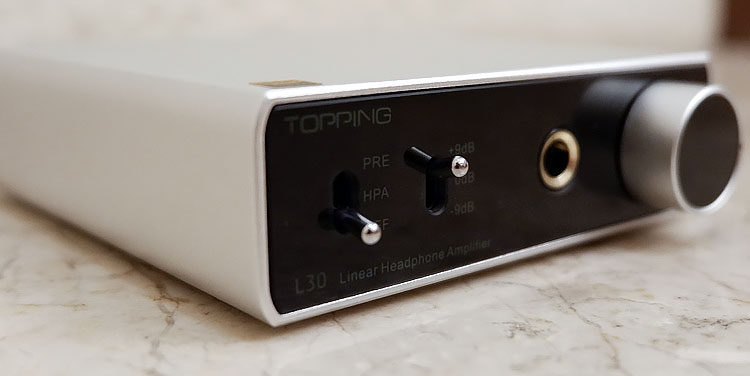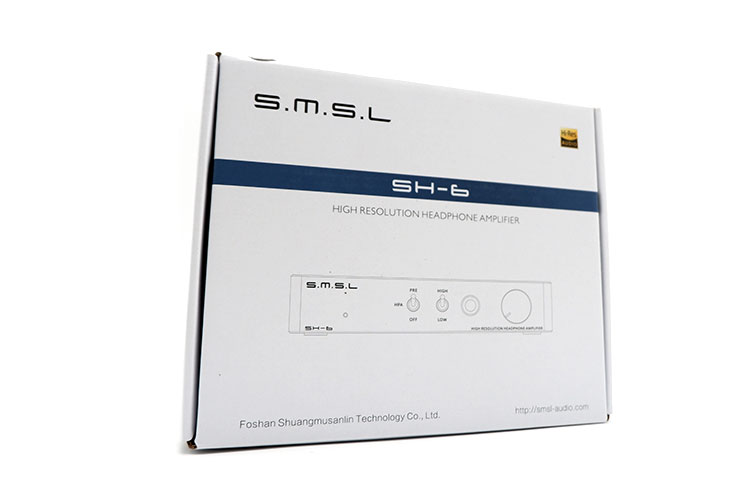This review covers the new SMSL SH-6 which is an affordable desktop solid-state headphone amplifier capable of up to 2.6W of output power. It is priced at $119.99.
Disclaimer: This was sent to us as a sample for our honest opinion. Headfonics is an independent website with no affiliate links or services. We thank Shenzhen Audio and SMSL for giving us this opportunity.
To read more about SMSL products that we have featured on Headfonics click here.
Note, this 2-page article follows our latest scoring guidelines which you can read up on here.
The first images that pop into my head when I try to think of a headphone amplifier at the sub-$150 price point are units such as the Schiit Magni and the Topping L30.
While SMSL has been doing well with the higher price bracket, even bringing a balanced topology to the sub-$250 price point with the SP200 and then later the SH-8s, they haven’t broken into the sub-$150 price point, until now.
Just like the SU-6 DAC that it’s partnered with, the SH-6 is a headphone amp that pushes the boundaries of what a sub-$150 can be. While the SH-6 takes up very little space, this little device is packed with features that haven’t been seen from SMSL at this price point, until now.

Tech Highlights
At the core of most of the latest amplifiers from SMSL is the PLFC, (Precision Linear Feedback Circuit), topology.
Interestingly, the marketing material on the SH-6 states that it has a Precision Feedback circuit inside, so meaning it’s not linear? Whatever the name may be, this topology is capable of keeping distortion as low as 0.00006%, which is in line with results from the best amplifiers in the industry.
To feed the Precision Feedback circuit, the SH-6 is equipped with a very quiet power supply that has a measured ripple voltage of just 1.3µV.
Despite the diminutive size of the SH-6, it’s capable of pushing out 2.6W into 16Ω and 1.3W into 32Ω. And then to ensure that your headphones are kept safe from being fried, the SH-6 is equipped with overvoltage protection, thermal protection, and DC voltage filters.
Design
Designed to complement the SU-6 DAC, the SH-6 comes in the same chassis size, and also comes in 2 colorway options, black, and silver. The one that arrived with us is the black option, and it perfectly matches the finish on the SU-6. However, being designed as a pure amplifier, the SH-6 doesn’t need to have a screen, instead, it features 2 toggle switches.
Then there is a volume knob that would initially seem very small but surprisingly feels comfortable partly because it protrudes out of the chassis enough to allow for a firm grip.
The rear of the device has the input and output options, and then there’s an IEC C7 type plug with a ground connection, which is a less common connection, but I’m assuming that this was chosen to save some space.
I/O
Being a straight-up SE headphone amplifier, the SH-6 only has a pair of RCA inputs and a 6.35mm SE headphone output in the front. However, the SH-6 is also equipped with a pair of RCA pre-outs, which can be used for a pair of powered speakers.
Controls
Looking at the rear of the device, there is a power switch, which physically isolates the mains from the internal circuity. However, I’m glad to see that SMSL didn’t take cues from Schiit, and instead still maintained a power switch in front, which is an option in the 1st 3-way toggle switch, which also allows the selection of either being a preamp out or a headphone amp out.
Then the 2nd switch allows for alternating between low and high gain. Finally, there is a volume knob on the far right of the device, which is satisfying to turn while being precise despite its size.
Packaging & Accessories
The box that the SH-6 comes in is what I’ve come to expect with most SMSL products, where there is SMSL branding in front, and then there’s a picture of the product. Opening the box shows that there are foam inserts that ensure that the amplifier is kept safe during transport and storage.
I don’t expect much from the package when it comes to amplifiers, and the SH-6 is no different, as it only has a few things by way of accessories. It only has the power cord and a 6.35mm to 3.5mm adaptor as accessories aside from the manual and other printed material inside the box.
Sound Impressions
Summary
The size of the SH-6 would suggest that it would do some artificial trickery to make it sound warm or engaging. However, the SH-6 keeps its composure by maintaining a generally even-handed tonal balance while having a fairly detailed presentation throughout the frequency spectrum.
If there’s anything that I would find lacking in the SH-6’s presentation, it would be the girth and heft in its presentation. Images and notes within the soundstage can sound a bit smaller and thinner despite a generally accurate placement.
Timbre
Despite the SH-6 being on the thinner side, the bass notes remain tight, allowing drum hits to sound controlled while exhibiting the hollowness of the drum cavity. However, bass notes tend to sound rounded, lacking that last bit of texture. Notes from bass guitars also sound a bit thinner, lacking that last bit of timbral accuracy.
Although the bass on the SH-6 is not the most prominent or full, the bass extends well into the sub-bass region. This allows underlying bass notes to sound deep, while mid-bass notes tend to sound more prominent.
Similarly, the vocal range tends to sound thin, while easily conveying a good amount of detail retrieval and vocal texture. The thinness also ends up making vocals sound more honest, while not injecting any artificial euphony into the mix. Guitars and pianos, on the other hand, tend to sound more striking and plucked, while lacking warmth and body.
The SH-6 presents cymbal hits with detail and shimmer while lacking that last bit of bite and edge. Wind instruments have a lack of body and airiness which results in the horns sounding a bit smaller than I expected them to be.
Staging & Dynamics
Although there is a lack of airiness, the placement of the images within the soundstage is quite accurate, allowing the lateral positioning of the images to remain accurate. However, when it comes to layering, the images tend to occupy a thinner layer within the space, while having a more intimate soundstage presentation.
Synergy
Power
For this level, 2.6W into 16Ω is impressive for a single-ended amplifier and easily powered most of the headphones in my collection. Including more demanding planar magnetic headphones like the Dan Clark Audio AEON 2 Closed, only requiring me to go up to 11 o’clock on high gain to reach my normal listening levels.
With my dynamic driver headphones, the HD600 only required me to push the SH-6 to 10 o’clock for comfortable listening levels.
On the flip side, the likes of the FiiO FH3, which requires much less power only required about 11 o’clock on low gain for comfortable listening levels. More importantly, I wasn’t able to hear any hiss on the headphone amplifier even when there isn’t any music playing.
Pairings
Having a more even-handed tonal balance allows the SH-6 to play well with a wide variety of headphones and IEMs depending on the upstream DAC that’s connected to it.
With the SU-6, which tends to have a more engaging character, the SH-6 pairs superbly with the Sendy Audio Apollo, which lends a more spacious character to the chain while maintaining an engaging and detailed listening experience.
For comparatively more engaging headphones, like the Sennheiser HD600, the SH-6 pairs well with more relaxed DACs such as the Topping E30 or even the Loxjie D30. This results in a more full-bodied experience while drawing you into the rich and textured midrange afforded by the HD600.
Similarly, with IEMs, the FiiO FH3 made a great pairing with the SH-6, as this gave the IEM an improved dynamic range, allowing for a more spaced out soundstage presentation.
Select Comparisons
Topping L30
$139
Technical
Coming from a brand that’s usually cross-shopped with SMSL products, the newer SH-6 seems like SMSL’s answer to Topping’s L30.
It shouldn’t be a surprise that both amplifiers have a similar set of features, both having single-ended inputs and outputs, as well as a preamp option. However, the L30 uses Topping’s proprietary NFCA topology, which allows it to achieve a 0.00007% THD.
When it comes to power, however, the L30 can actually produce almost 1 watt more at 3.5W into 16Ω while having 3 gain settings that allow for even more precise volume control.
Design
Both amplifiers take up a similar amount of desk space, with the L30 being more narrow while being deeper. However, the L30 requires the use of a wall wart power supply that houses a transformer inside, so it might be more difficult to plug into the socket particularly if your power strip is a bit crowded.
The input and output options on the 2 amplifiers are also very similar, with both having a single-ended headphone amplifier output, as well as single-ended RCA inputs and outputs. However, the more glaring difference between the 2 amplifiers is that the L30 has 3 gain stages.
Controls on both amplifiers are also very similar, with both devices primarily relying on toggle switches, which allows quick switching between the different available options.
While both amplifiers use the 1st toggle switch for input selection and switching off the amplifier, the L30 doesn’t have a mains switch at the back that can be used to physically disconnect the amplifier from mains power.
Performance
Both amplifiers aim to achieve a neutral tonal balance, and to some extent, they both achieve this well. However, the L30 has a comparatively warmer tonal balance, while having less control over the bass region resulting in a woolier bass presentation.
The vocal presentation, on the other hand, ends up being more planted on the L30, while adding a bit more air and euphony into the mix. However, the textures of midrange instruments, as well as vocals, tend to be less defined. Similarly, treble also ends up being less defined, making cymbal hits sound more blunted comparatively.
While both don’t cast a particularly expansive soundstage, the L30 casts a comparatively more dispersed soundstage presentation. However, this comes at the cost of image separation and delineation.
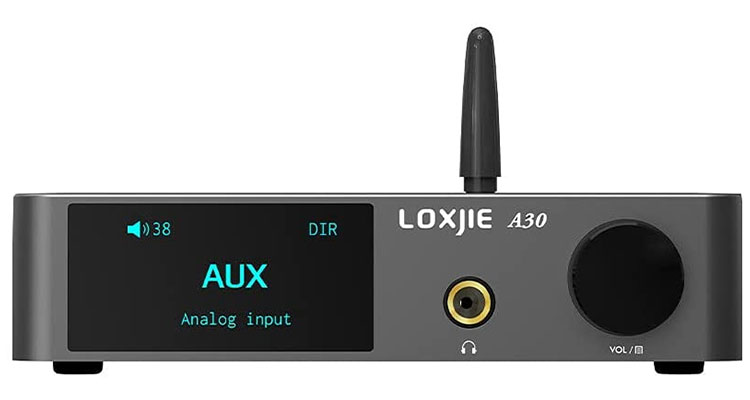
Loxjie A30
$189.99
Technical
Looking at the price, the A30 is at a significantly higher price point, however, the A30 has a few extra features like having an internal DAC, Bluetooth, and even speaker output terminals. I would say that these features make up for the price difference.
On paper, the A30 has a much lower rated power output at 100mW into 32Ω, which shouldn’t be much. However, what’s surprising is that the A30 can power most of the headphones that I throw at it, so I highly doubt that the power on the A30 is capped at 100mW.
At the core of the A30 is a MA12070 class D power amplifier chip, which is used to power the speaker terminals, and I’m sure that a portion of that power is routed to the headphone output section.
Controlling the volume on the A30 is an NJW1194 volume control chip, which ensures more accurate channel tracking than traditional potentiometer-based volume control.
Design
Having the power to push speakers requires that the A30 would be a much larger device, at about double the footprint. Then, it also has a 24V external power brick, which makes it take up even more space, but with its capabilities, I’m not surprised at the overall dimensions of the A30.
Being a more feature-rich device, the A30 has a 1.9” TFT screen, and remote control. However, this control scheme also makes it a bit more difficult to change the volume or go through the different available options, since it would require more button clicks than simply flipping different toggle switches.
Performance
Having a class D amplifier powering the A30, it’s natural that it would have a better sense of attack and decay, giving it a comparatively speedier character. However, this doesn’t translate to having a more detailed presentation. Instead, it results in tighter bass control while presenting a less textured bass region which comparatively lacks texture and hollowness.
Having a more planted vocal fundamental allows the A30 to inject a splash of euphony into the vocal presentation. However, the detail retrieval capability of the A30 is a step behind, making it more difficult to make out vocal texture and nuance. The treble presentation is comparatively more subdued, making it less engaging despite both amplifiers steering away from sibilance.
The soundstage presentation on the A30 is comparatively more closed in, making it more difficult to space out the images within the soundscape. This results in having images crash into each other more often on the A30. The placement of the images within the soundstage is similarly accurate though.
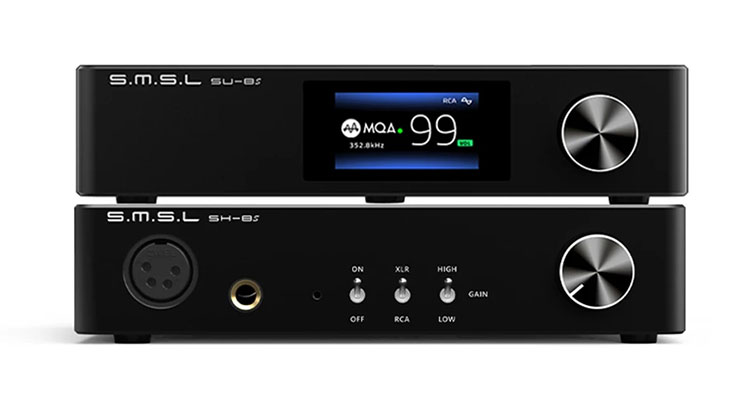
SMSL SU-8s
$229
Technical
Being the next step in SMSL’s headphone amplifier lineup, the SH-8s has a few extra features, which include the use of SMSL’s proprietary PLFC(Precision Linear Feedback Circuit) topology.
The SH-8s also have a quiet power supply which has a measured ripple voltage of just 1.3µV. This allows the SH-8s to have a diminishingly low measured THD of 0.00006%, which makes the measurements on both amplifiers very similar.
What brings the SH-8s to the next level though is the rated power output, where it has 4x the rated power output at 6W into 16Ω. Also, the SH-8s feature both balanced and single-ended inputs and outputs. What’s glaringly missing though is that the SH-8s don’t have any pre-amp outputs,
Design
Looking at the 2 amplifiers side by side, the SH-8s seem like a larger version of the SH-6 since they share the same matte black finish, and even the toggle switches in front of the SH-8s have 1 more toggle switch.
However, the SH-8s have a larger volume knob with a different finish. Also, the front of the SH-8s has both a balanced 4-pin XLR output and a ¼” single-ended output.
At the rear, the SH-8s have a bit more space since it doesn’t have a pre-amp output while it has a choice of either a pair of single-ended RCA inputs or a pair of 3-pin XLR inputs. Being a larger device, the SH-8s also uses the larger IEC C13 inlet which is more ubiquitous for when you would want to use an aftermarket power cable.
Performance
Coming from the same stable, the 2 amplifiers would definitely have some similarities, particularly with the tonal balance. Both amplifiers have a generally even-handed tonal balance with an emphasis on creating a crisp and detailed presentation.
However, the most prominent change between the 2 amplifiers is that the SH-8s has a more physical bass presentation. Bass notes have a sense of scale while having an accurate sense of attack and decay, allowing details to come through without bleeding into the rest of the frequency spectrum.
The midrange is similar on both amplifiers, with the only difference being that the SH-8s has a more textured and euphonic presentation. Treble on the SH-8s is pulled back by a hair while having a similar level of detail retrieval and texture.
Although neither amplifier is artificially airy, the SH-8s has a comparatively wider soundstage presentation while the placement of the images is similarly accurate. What sets the SH-8s apart though is that it sounds less compressed while having the ability to create comparatively larger looming images within the soundstage.
Our Verdict
Based on the ads, I was expecting the SH-6 to be a bit larger, but I was pleasantly surprised at how compact the chassis of the SH-6s ended up being. Together with the SU-6, the SH-6 can easily be used to create a highly capable headphone system without taking up much space.
However, the size of the SH-6 shouldn’t be used as a basis for estimating the extent of the SH-6’s abilities. As a headphone amplifier, the SH-6 creates an even-handed presentation not relying on injecting anything into the music.
Instead, the SH-6 mainly relies on its ability to convey an honest musical presentation only falling short in its ability to present an accurate sense of scale which can be said to be proportional to its physical size.
SMSL SH-6 Amplifier Specifications
- Inputs: RCA
- Headphone outputs: 6.35mm unbalanced
- Pre-output: Unbalanced
- Output power: 2.6W x2 16Ω, 1.3W x2 32Ω
- SNR: 134dB
- Output noise: 1.3uV
- THD+N: -123dB, 0.00006% (1kHz, 32Ω)
- THD+N: -118dB, 0.00012% (20-20kHz, 32Ω, 0dB)
- THD: < -125dB, 0.00006%
- Input impedance: 47kΩ
- Amp output impedance: Near 0Ω
- Pre-out impedance: 22kΩ
- Frequency response: 20Hz – 500kHz (-3dB)
- Gain: Low (0dB), High (15.5dB)
- Power consumption (EN60065): <30W
- Power consumption in standby mode: <0.1W
- Size: 5.5 x 1.1 x 4.5” (140 x 28 x 115MM)
- Weight: 0.84lbs (0.38kg)

